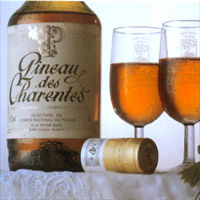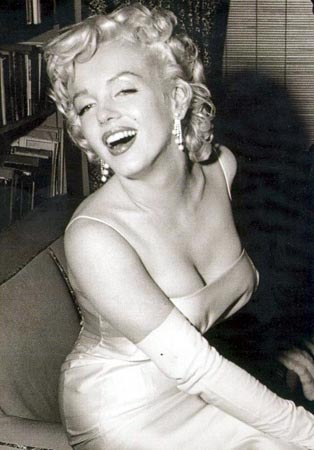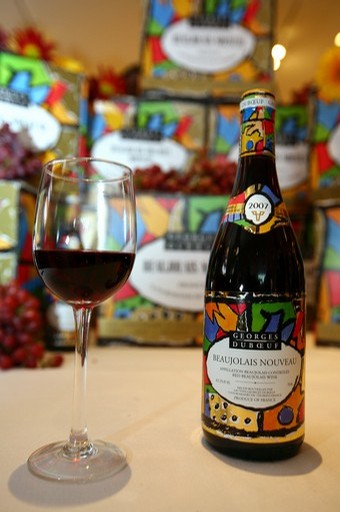 A few weeks ago I stumbled upon a rare treat in the larger wine world, particularly here in North America: Pineau des Charentes. When I saw that Joe the #1 Wine Dude had expanded this month's Wine Blogging Wednesday theme (maderized dessert wines) to include fortified wines, well, it was all I could do to hold off all reports on this fabulous little dessert/aperitif-perfect-for-apple-pie-or-in-front-of-the-fire-or-before-a-chic-meal find!
Pineau des Charetes is made from 2/3 unfermented must of fresh grapes and (drum roll please!) 1/3 COGNAC. This is my paradise.
A few weeks ago I stumbled upon a rare treat in the larger wine world, particularly here in North America: Pineau des Charentes. When I saw that Joe the #1 Wine Dude had expanded this month's Wine Blogging Wednesday theme (maderized dessert wines) to include fortified wines, well, it was all I could do to hold off all reports on this fabulous little dessert/aperitif-perfect-for-apple-pie-or-in-front-of-the-fire-or-before-a-chic-meal find!
Pineau des Charetes is made from 2/3 unfermented must of fresh grapes and (drum roll please!) 1/3 COGNAC. This is my paradise.
Old wives tales (or perhaps actual history) has it this fun beverage was created by mistake. How so? Well, apparently a grower back in the 16th Century poured grape must (the juice, skins, stems...) into a barrel that already contained Cognac (brandy). The barrel was out of sight/mind for another 5 years or so until a huge harvest came in and additional barrels were needed. Soon enough, the concoction was discovered. The stuff tasted so darn good - fruity, sweet, yet lighter and not cloying in texture - the folks in Charentes, France perfected the process and began peddling it to eager consumers.
This aperitif thrills me for a number of reasons. First, it is a rare find here in the United States. Somehow, the masses have failed to catch on to the glory that is this sweet, little libation. Second, most producers have not chosen to make Pineau, considering it a mere byproduct of Cognac; they simply use Ugni Blanc grapes, which is also used in the production of Cognac. Among those who do make Pineau part of their repertoire, the best wines are made from the freshest (read: from field to barrel in a single day), hand-picked grapes. Only by hand-picking can they know the moment when full maturity is acheived, when the golden grapes turn to a deep topaz color and, for the red wines, when the black grapes turn from crimson to brown.
Pineau des Charentes is often found at 18% alcohol - the optimal level. It must remain in bottle for at least one year before it is sold (and often the best producers wait as much as five years before releasing it). As I alluded above, Pineau is offered in Or (white) or Ruby (red) varieties. In the case of the Ruby, Cabernet, Cab Franc or Merlot varietals are used.
If you've never enjoyed Pineau before or after a meal, please do. You are missing out! For those who don't prefer overly sweet dessert wines, this should be a good fit. Pineau certainly can accompany a little pastry, tart, or ice cream dessert. But it is also delightful with foie gras, oysters, poached fish, goat cheese, Roquefort and even fine game. (Use your gut instinct on which - red or white - variety pairs best with each of these suggestions.) Just avoid consuming Pineau with any 'strong' flavored sauces or dishes, even as simple as olives. It'll taste a little funkity funk....
For Wine Blogging Wednesday I served the Domaine du Perat Or with apple pie two weeks ago. The fruits in the Perat were reminiscent of stewed peaches and ripe apricots. But it also offered a depth of flavors you'll find reminiscent of cognac (burnt caramel nuttiness) - without the burn. Serve chilled, for optimal flavors.
I'm curious how well received Pineau still is in France these days... do you know? If you're from North America, is this post a throw back to days of old for you? Or is Pineau de Charentes a new one on you?
 As the first gentle snowflakes of the winter were falling here in Boston yesterday morning, I was up and at'm reading wine reviews. It's true I'm always doing research. But yesterday somehow the stage was set such that I couldn't help chuckling at some of the terminology in our wine lexicon! Have you ever noticed how often a wine - or maybe just the BEST wines - are described by some of the most colorful lingo of any (neutral) topic?
Some of the best terms (for the best wines) are words any woman would love to have poured over her (perhaps literally and figuratively!). A few of my favorites are: Smooth, Elegant, Alluring, Enticing, Polished and Supple.
As the first gentle snowflakes of the winter were falling here in Boston yesterday morning, I was up and at'm reading wine reviews. It's true I'm always doing research. But yesterday somehow the stage was set such that I couldn't help chuckling at some of the terminology in our wine lexicon! Have you ever noticed how often a wine - or maybe just the BEST wines - are described by some of the most colorful lingo of any (neutral) topic?
Some of the best terms (for the best wines) are words any woman would love to have poured over her (perhaps literally and figuratively!). A few of my favorites are: Smooth, Elegant, Alluring, Enticing, Polished and Supple.


 The sun is shining here in Boston and I'm off to a Grower Champagne tasting in a little while. Yes, I have something to feel jolly about! But as I was telling friends about my afternoon plans, I remembered many people don't know the tremendous loveliness that is Grower Champagne - or what I'm so excited about. So today I'm going to launch my latest Wine Wednesday theme: A Bit on Bubbly.
There's much to be understood
The sun is shining here in Boston and I'm off to a Grower Champagne tasting in a little while. Yes, I have something to feel jolly about! But as I was telling friends about my afternoon plans, I remembered many people don't know the tremendous loveliness that is Grower Champagne - or what I'm so excited about. So today I'm going to launch my latest Wine Wednesday theme: A Bit on Bubbly.
There's much to be understood  I was blessed with three things this Thanksgiving: inspiration, hope and pure delight. Since wine happened to be the catalyst for all three (and I feel like all we hear about is bad news these days), I can't help but pick up my blog after the holiday weekend and share some positive goodness.
Inspiration. I've never had so much fun interacting with wine customers than last Wednesday night at the shop. People were looking for nice bottles of vino to accompany their meal, serve as delicious liquid 'balm' for potentially awkward family moments, or otherwise thank their host for their hospitality. People were simply in good spirits, looking forward to a few days off and satisfied bellies. Their bottle of vino was something they not only wanted to complete their meal, but to say something more, too.
I was blessed with three things this Thanksgiving: inspiration, hope and pure delight. Since wine happened to be the catalyst for all three (and I feel like all we hear about is bad news these days), I can't help but pick up my blog after the holiday weekend and share some positive goodness.
Inspiration. I've never had so much fun interacting with wine customers than last Wednesday night at the shop. People were looking for nice bottles of vino to accompany their meal, serve as delicious liquid 'balm' for potentially awkward family moments, or otherwise thank their host for their hospitality. People were simply in good spirits, looking forward to a few days off and satisfied bellies. Their bottle of vino was something they not only wanted to complete their meal, but to say something more, too. I'm cooking a harvest-themed feast for a few friends this year and couldn't be more thankful to avoid the madness of travel including, but not limited to: airport delays; someone else's Aunt Tilda and her generous supply of lipstick and perfume; and the screaming baby in the seat across the aisle. I'm not a Bah Humbug for Christmas, but I've lived through too many challenging Thanksgiving trips to want to head elsewhere for the otherwise great event. An entertaining parade that inspires nostalgia, football (no matter how bizarre the match-up), a feast chock full of friends and good humor and a great bottle of wine (or two or three) are all the ingredients I need for a lovely day of giving thanks.
If you haven't made it to your wine shop to select a bottle of wine this year, today might be a good day to drop by. It will only get trickier to navigate the aisles as mid-week approaches. And if you don't already have a favorite Pinot Gris, Riesling, Beaujolais Villages, or Pinot Noir picked out, remember to consult your shop's wine buyer. There are some fun things on the market this year you won't want to miss. (Two that come to mind are the
I'm cooking a harvest-themed feast for a few friends this year and couldn't be more thankful to avoid the madness of travel including, but not limited to: airport delays; someone else's Aunt Tilda and her generous supply of lipstick and perfume; and the screaming baby in the seat across the aisle. I'm not a Bah Humbug for Christmas, but I've lived through too many challenging Thanksgiving trips to want to head elsewhere for the otherwise great event. An entertaining parade that inspires nostalgia, football (no matter how bizarre the match-up), a feast chock full of friends and good humor and a great bottle of wine (or two or three) are all the ingredients I need for a lovely day of giving thanks.
If you haven't made it to your wine shop to select a bottle of wine this year, today might be a good day to drop by. It will only get trickier to navigate the aisles as mid-week approaches. And if you don't already have a favorite Pinot Gris, Riesling, Beaujolais Villages, or Pinot Noir picked out, remember to consult your shop's wine buyer. There are some fun things on the market this year you won't want to miss. (Two that come to mind are the 

 I was raised in a family where asking someone about finances - or their buying power - might be considered a little too forward. But one of the most helpful questions I've learned to ask a customer searching for the "perfect" bottle is "how much do you want to spend?". I'm sure I've said it before: there is a ton of great juice on the market. Knowing how much someone wants to spend helps me narrow the playing field and help them find a great bottle to suit the occasion.
Often I meet people who know they want to bring a bottle to dinner, but feel uncomfortable with wine and don't feel they know what is an appropriate amount for a "good" bottle of wine for X occasion. A good salesperson will be able to steer you in the right direction - without making you feel uncomfortable. But failing that ideal experience, here are a few things to consider when shopping (particularly given the economic climate and the upcoming holidays).
I was raised in a family where asking someone about finances - or their buying power - might be considered a little too forward. But one of the most helpful questions I've learned to ask a customer searching for the "perfect" bottle is "how much do you want to spend?". I'm sure I've said it before: there is a ton of great juice on the market. Knowing how much someone wants to spend helps me narrow the playing field and help them find a great bottle to suit the occasion.
Often I meet people who know they want to bring a bottle to dinner, but feel uncomfortable with wine and don't feel they know what is an appropriate amount for a "good" bottle of wine for X occasion. A good salesperson will be able to steer you in the right direction - without making you feel uncomfortable. But failing that ideal experience, here are a few things to consider when shopping (particularly given the economic climate and the upcoming holidays).
 A few weeks ago I stumbled upon a rare treat in the larger wine world, particularly here in North America: Pineau des Charentes. When I saw that
A few weeks ago I stumbled upon a rare treat in the larger wine world, particularly here in North America: Pineau des Charentes. When I saw that